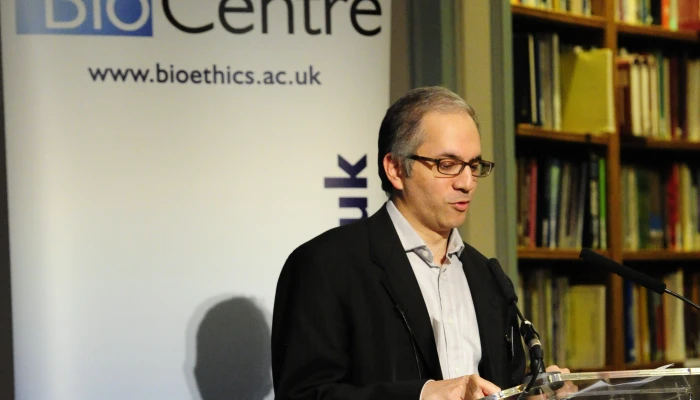
BioCentre’s recent event Creating a culture of innovation for Healthcare formed part of the Economic and Social Research Council’s Festival of Social Science 2012. It took place on Monday 5th November 2012 2:30–5pm at the Charles Darwin Conference Centre, London.
One common thought I perceived throughout the event was the need to put the patient at the heart of healthcare innovation, all the way from the technology design process to the actual clinical observations and procedures.
Imagination and a pile of junk
The first speaker was Prof David Napier, Professor of Medical Anthropology with University College London. He started out by quoting Thomas Edison:
“To invent, you need a good imagination and a pile of junk”. This start gave him all the crucial elements about invention and change in one go: what it means to invent, what constitutes a good imagination and what on earth does he mean by a pile of junk?
It does ring very true: once we actually understand what an innovation is, we can start looking at how people actually make this happen. The work of Daniel Kahneman springs to mind, especially since Prof Napier mentioned how Edison had around 25 naps a day, perhaps blurring the line between his dreamtime and waking time and therefore activating his slow thinking, S2 system. When looking at the distinction between innovation and invention we see that sometimes we can be very good at innovation, yet very poor at invention.
Then, what is the difference between modify existing art and creating new art? In order to bring about non–obvious differences, knowing the art/technology long enough is essential. Innovators have to think about and know what the state of the art is, and then somehow modify it. Inventors are very different people – they don’t know what the outcome will be as it comes from superimposing unlikely things – this is where junk comes in.
The question, as applied to increasingly restrictive working environments, is how does blue–sky thinking get preserved in this framework? This is perhaps the biggest challenge with coming up with new innovations and inventions that affect the way we behave.
I agree with the professor’s conclusion that if we can combine the new emerging technologies that we find useful applicable and helpful with an awareness of how people can be brought to them and actually be able to take advantage of them – and in the process identify what are the limitations in having the people be able to try something new – then the chances of success will be much higher. As technologists and designers we should be in a constant feedback loop with the users, and methods from the field of human–computer interaction can come in very handy.
Role of technology in innovation
The next speaker was Professor Daniel Steenstra, Royal Academy of Engineering Visiting Professor in Innovation, with a particular focus on medical and healthcare technology at Cranfield University. His talk focused on the role of technology in innovation – how should we do it, especially looking at the current state of healthcare in the world – as the demand is something that taxpayers cannot afford anymore. When looking at the NHS, obviously quick spit and polish efficiency is not going to work, as it’s just not enough. We need to be much more radical about whole system innovation, and a large part could be played out by technology. We have come a long way from the mainframe room–sized computers of the ‘80s. Technology is now centered around us, yet we still experience what the professor called “temples of technology” – we have to go to the hospital in order to be blessed by the advancements of modern medicine. Why should the healthcare experience be hindered by technology?
On the one hand, we have technology that the NHS cannot use because it takes years for doctors and nurses to learn to use it properly. On the other, patients are taking matters into their own hands, hacking away at their smart–phones and sometimes their bodies, using self–monitoring tools and sharing all sorts of data. So the question is really how do we get smart healthcare delivered closer to the patients? How do we get the technology out of hospitals and in the patients’ homes? One answer lies in involving them in design process, coming up with new processes and techniques so that patients can be involved in the design of new technology and healthcare standards.
Policy and the Public
The responsibility of taking these ideas and turning them into the next generation of healthcare lies in the hands of people such as the next two speakers, Dr. Alison Prendiville, Deputy Director of the multidisciplinary Centre for Design, and Mirella Marlow, Programme Director with the Devices and Diagnostic Systems, Centre for Health Technology Evaluation, National Institute for Health and Clinical Excellence (NICE).
NICE’s role is to find and evaluate medical devices and diagnostics and recommend the ones that are clinically and cost–effective for the NHS (that has to save 25% of its budget over the next years). So how do you introduce innovations into routine use? You need programs that evaluate and produce guidance on clinical procedures, diagnostics, pathways to care, public care. You have to work with industry, clinicians, public, academics and NICE uses a deliberative decision process. The decision making body has expertise in synthesizing all these sources of evidence and information into practical recommendations. In particular, when evaluating new design methods, medical technology, devices and diagnostics to be implemented into the frontlines of the NHS, the ultimate question is: CAN IT BE USED?
As many guests commented during the reception afterwards, the afternoon event probably helped to spark more questions than it did answers. But that in itself helped to bring this important issue to the forefront of people’s mind and to start us all thinking now about what kind of healthcare we all want in the future and the place that innovation plays in this.





